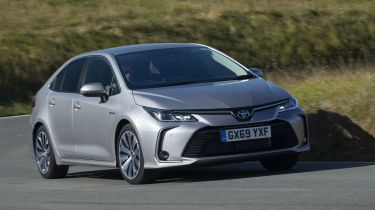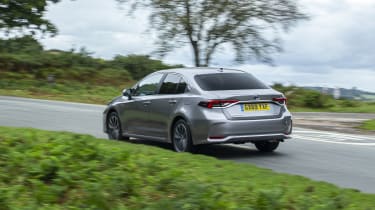Toyota Corolla Saloon (2018-2021) review
The hybrid Toyota Corolla Saloon is a well executed car in a class with few rivals

Pros
- Generous kit list
- Quiet when cruising
- Low running costs
Cons
- Only one engine choice
- Noisy when accelerating
- Less practical than hatchback
| Car type | Fuel economy | CO2 emissions | 0-62mph |
|---|---|---|---|
| Hybrid | 53-63mpg | 102-111g/km | 11.0s |
Britain’s hybrid saloon market isn’t very big, but that hasn’t discouraged Toyota from entering it with the Corolla Saloon. The hope is that it'll attract some of the buyers who liked the old Avensis, which Toyota killed off in 2018. The Corolla Saloon costs exactly the same as its hatchback sibling, although it benefits from extra space inside, because it uses the same platform as the larger Touring Sports estate. The downside is that the saloon misses out on the 2.0-litre hybrid engine, so you’ll have to settle with the performance offered by Toyota’s 1.8-litre powertrain.
Icon, Icon Tech and Design trims are available, although standard kit is generous enough to make the entry-level Icon worthwhile. With 120bhp on tap, the Corolla Saloon will propel you from 0-62mph in 11 seconds and on to a top speed of 112mph; adequate, but far from thrilling. CO2 emissions of just 102g/km on 16-inch wheels – or 111g/km on 17-inchers – will be far more relevant to potential buyers, with a resulting Benefit-in-Kind company-car tax rate of 24-26% for 2021/22 – a slight advantage over petrol and diesel rivals.
Fuel economy ranges from 53-63mpg, and Toyota believes that gentle use of the accelerator pedal will make it possible to cover up to half of all urban miles using no fuel at all. If you do a lot of city or town driving, this makes the Corolla a tempting proposition. Indeed, interest from minicab drivers is expected to be strong. On the motorway, the Corolla Saloon is happiest at a steady cruise: it’ll coast along at 1,000rpm with the engine barely audible, although you’ll still hear some wind noise from the wing mirrors and some tyre roar from the wheels. Even so, it’s still a relaxed car.
That changes somewhat when you accelerate quickly, which forces the CVT gearbox to drive the revs up until you reach your desired speed. This aspect of the car also holds it back on twistier roads: the Corolla is actually quite composed in corners, but the gearbox really isn’t designed for fun, spirited driving.
The interior of the saloon is more or less identical to the hatchback and estate, with lots of soft-touch materials and good build quality. The larger proportions of the Corolla Saloon make it roomier and more comfortable than the hatchback, with better knee and legroom throughout. That said, the swooping roofline does little for headroom in the rear, and it isn’t possible to lower the rear seats for extra carrying capacity. The 471-litre boot is a useful size, however, and it’ll hold a pair of suitcases and rucksacks with ease.
The Corolla Saloon has few direct rivals, but chief among them is the Ford Mondeo Hybrid: it’s as economical as the Corolla on paper, but more costly to purchase. For a more detailed look at the Toyota Corolla Saloon Hybrid, read on for the rest of our in-depth review...




